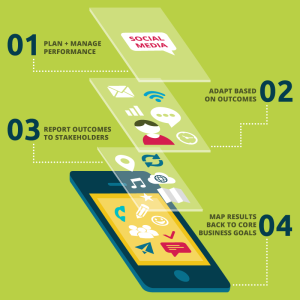 In the first blog of this two-part series, I explained the ROI-driven steps that marketers should take when planning social media strategy.
In the first blog of this two-part series, I explained the ROI-driven steps that marketers should take when planning social media strategy.
Developing a social media plan and using a scorecard are critical to determine our success, know where we are falling down and quickly make changes in our strategy and tactics. This is especially applicable when it comes to social media, both because it is seen as a “nice to have” by some executives, and as an accountable marketer, you have to guard against investing lots of people and technology cycles with little to show for the investment. You can quickly burn through time, resources and budgets, and you run the risk of executives growing weary of social media as a core marketing/customer communications strategy.
As I did with my four-step plan to build successful social media strategy, I’m going to lay out the four steps needed to measure and adapt that strategy post-launch to keep your stakeholders enthusiastic – while building your social presence and results.
Step 1: Proactively plan, manage performance
The strategy you build from the outset should include a healthy dose of performance planning and “instrumentation.” You aim to deliver on a self-fulfilling prophesy; you should only conduct social activity that you can measure, and only promise results that you have confidence you can deliver.
In this first stage, you’re conducting tightly controlled monitoring and measurement within marketing and NOT widely sharing results with stakeholders until you have performed the next step in the process. Some of the key data you are trying to get your arms around is:
- What are the channels or social networks where my prospects, customers and/or industry influencers frequent, share and dialog?
- What content and format (graphics, pictures, and article links, for example) is most engaging and generates interactions, site visitors and downloads?
- What types of messaging and tone of voice works best for the different profiles of people I am targeting?
- What days/time of day is best to post in the community I am targeting?
This initial work provides a scope of establishing benchmark metrics that will make up your scorecard and give clear signals of what’s working and what’s not.
Step 2: Adapt based on outcomes
With metrics and measurement tools in place and a mindset of always monitoring, you now need to understand the dials you need to turn – messaging, content, channels, timing discussed in the bullets above – to deliver on the metrics you’ve established.
You need to always have additional content at the ready. Be prepared to try additional channels or sites and to regularly update communications, based on learnings. An important way to be efficient and effective is to activate new creative concepts you’ve planned as part of the bigger strategy, as opposed to building new content and messages from scratch. This agile approach is the only way you can tweak near-term outcomes and determine how you will continuously optimize your campaigns going forward.
Step 3: Report to management/stakeholders on your outcomes
Once you’ve got enough experience and results – and the results are in line with what you’ve promised – it’s time to start reporting to management on the impact of your social activities and investment.
Do NOT overdo the technical details, the data or the explanation on what you’re doing. Keep the focus on business results and outcomes – in terms that mean the most to those you’re presenting to (revenue and ROI to finance execs, pipeline to sales execs, mindshare or engagement for marketing execs). Always refer back to what you’ve promised, and how you’re meeting or exceeding those expectations.
Straightforward, clearly labeled charts and graphs leave a lasting impression. This is not a matter of hiding details – in fact, they should be available in your appendix – but 100% disclosure is not a requirement. Delivering compelling ROI is.
You’re telling a story to those who most likely lack social media expertise so the key is to tell your story in their terms, leading with numbers and outcomes that resonate.
Don’t forget to share the next strategic steps you’ll be taking, how you’ll quantify them and when you’ll do so. It’s a matter of setting achievable expectations, then meeting them – repeating Step 1 above.
Step 4: Always map results back to core business goals
This is a logical extension of Step 3, yet it’s important enough to call out separately. Many business executives you’ll be reporting to have NOT grown up in the mobile/social/cloud era, and may find themselves scrambling to keep up – or even develop a baseline understanding of social media’s value.
A big part of your role is to educate them by tying every social initiative back to a business goal (pipeline, revenue, awareness) that resonates, while maintaining the laser focus on ROI. Social media is a means to achieving business results – complementing many existing marketing/sales channels – and it should always be expressed in that way.
As you build the comfort, and confidence, of your executive leaders, you can set yourself up as a resource to them, while continuing to build out your professional portfolio of achievements in social media.

This article was syndicated from Business 2 Community: How To Plan Social Media Performance, Deliver ROI
More Digital & Social articles from Business 2 Community:
- What Are The Best Social Media Platforms For Your Business?
- 10 Social Media Stats You Might Not Know (But Should)
- What You Need to Know About Email Marketing: Statistics and Trends [Infographic]
- 10 Simple SEO Mistakes to Avoid
- 7 Social Media Marketing Mistakes That Will Doom Your Business to Oblivion




